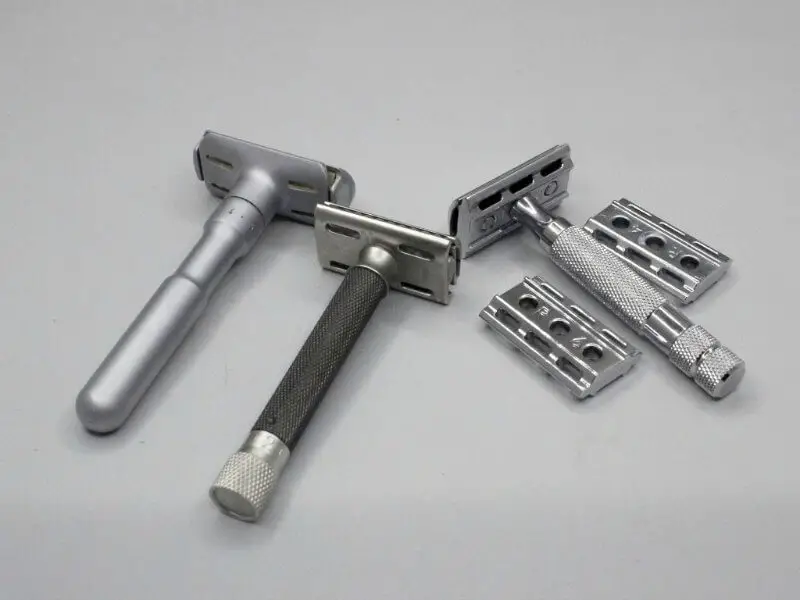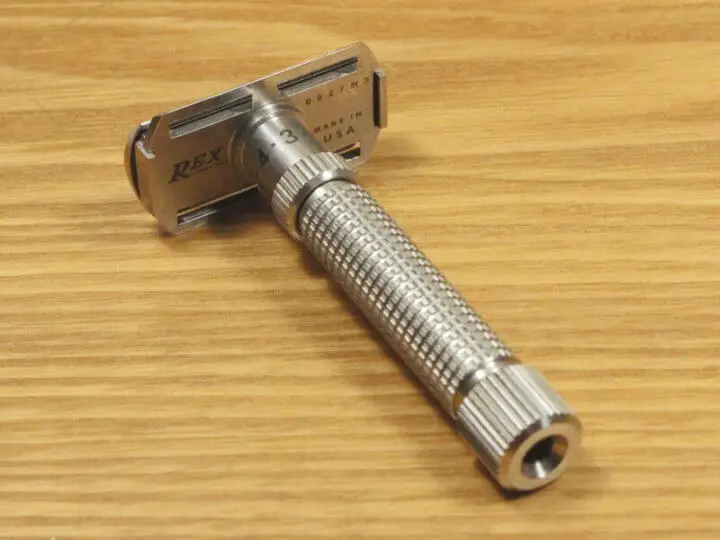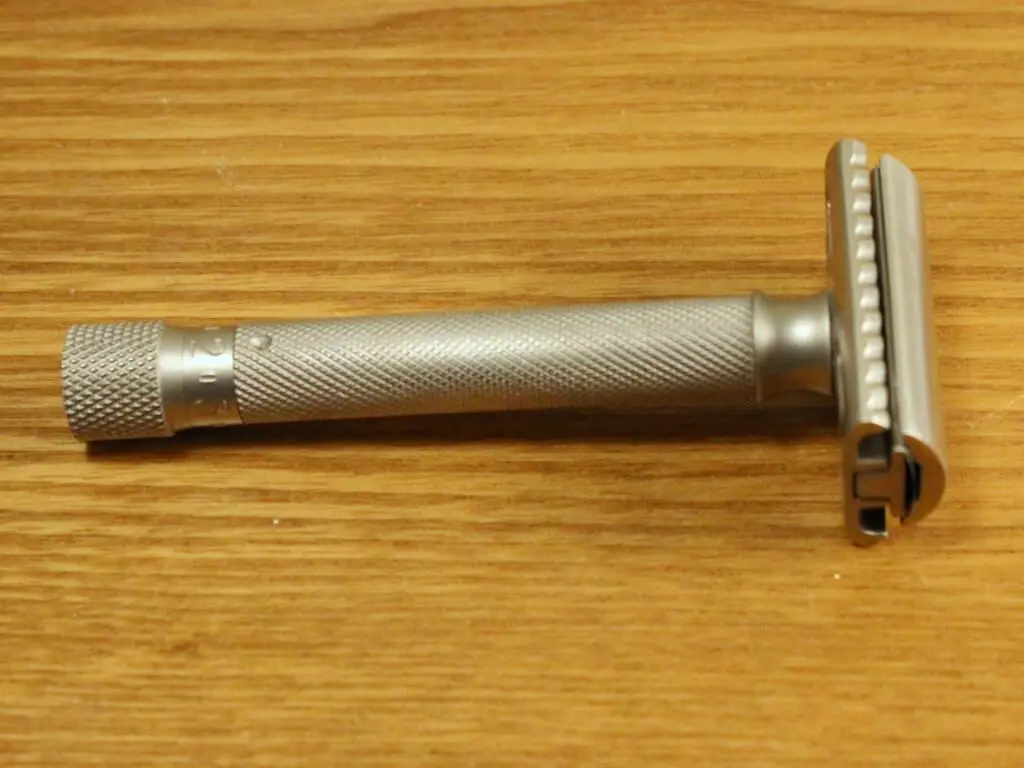
[Note from Mark, “Mantic59”: Doug Hansford recently sent me some thoughts about what is the “ideal” DE razor. By coincidence I had been thinking about this myself, and a lot of his comments tracked my feelings, so we decided to collaborate on this article.]
Characteristics of the Ideal DE Razor
Although there are many razors that, individually, may be ideal for a given person, the ideal DE razor meets the needs of virtually every shaver. What are the razor’s characteristics?
The first and essential characteristic of the ideal DE razor is that it is adjustable. Adjustability allows for the following:
- The shave character of a single razor can suit many users’ varied preference for shave aggressiveness from mild to wild.
- The razor can compensate for the state of individual blades: some, when new, can be too sharp and tend to wound. Also, most blades, as they progress through their useful life become less sharp, will still readily cut whiskers, but to get the best shave from each blade as it progresses through its life cycle, the aggressiveness of the razor usually will have to gradually increase.
- The razor can, at least partially, compensate for variables in prep and shave lather.
Some examples of adjustable DE razors include the following:
- Vintage Gillette adjustables such as the Fat Boy, the Slim, the Toggle, and the Black Beauty
- Merkur Futur and Progress (and the Progress after-market like the “Mergress”).
- Parker Variant – a variation on the the Merkur Progress design.
- Chinese-manufactured variations of the Merkur Futur design (such as QShave).
- Rex Ambassador
- Rockwell 6-series razors (6S and 6C), which offer multiple base plates as part of a three-piece razor design. The baseplate options give this design a kind of adjustability, though different from what may be commonly thought of as an adjustable DE razor.
Comfort?
The second and essential characteristic of the ideal DE razor is that its shave character is comfortable for most faces. This means having the appropriate blade angle within the razor head that tends to be optimally smooth and non irritating on most faces.
This requirement eliminates some of the preceding examples of adjustable DEs just based on our experience alone.
Doug is most familiar with is his 1963 Slim. he’s never been able to get a comfortable shave with that razor, no matter the blade or adjustment setting. Though the razor is in good condition, with all alignments as they should be, every shave he’s ever had with that razor is irritating at best. By contrast his Chinese variation of the Futur or the Parker Variant adjustables, consistently offer smooth, comfortable shaves.
Mark tried a late-50’s vintage “Fat Boy” adjustable (in great condition) for a while and had a similar experience: a consistent, comfortable shave was illusive. Trying a Merkur Progress was just the opposite and became his “out of my cold, dead hands” razor for many years (until the Variant, and later the Ambassador, came along).
Comfort vs. Character
This is not to say that some gents don’t get comfortable shaves with vintage Gillette adjustables like the Slim. They do, but that isn’t the issue. The issue is that the shave character of these razors is not well liked by some users, which would disqualify them as a candidate for the ideal DE. Now it can’t be said that all Gillette adjustable have the same shave character, but because they are vintage and not in current production, even if one or more of their models were ideal, there aren’t enough available to meet the needs of the masses. Therefore let’s to drop the vintage razors from consideration for reasons of availability alone.
The Futur-based design including the original might fall into this few-complaints category except for the size of the razor head, which some complain is too large to easily and safely shave all areas of the beard, and the adjustability range, which many find too far in the upper-end category (the lowest setting on a Futur is higher than the lowest setting on the Progress).
A third characteristic of the ideal DE is infinite adjustability. Having discreet adjustments like vintage Gillette or the Rockwell 6-series razors limits to an extent the ability to precisely dial in one’s preferred level of shave character. This flexibility comes in handy when tuning the aggression of a razor in the middle of a given shave. It also can come into play when comparing ideal settings for different blades or for a given blade in the various phases of its life cycle.
This tends to leave at least the following razors still standing:
- Merkur Progress and various Mergress variations
- Parker Variant
- Rex Ambassador
A subtle but potentially important characteristic is handle slipperiness (or lack of it). This tends to make the Progress/Mergress options less attractive due to their shiny smooth, fluted handles. This contrasts against the well-knurled Variant handles, which always remain securely grippable in one’s hand.

Another important factor that determines the ideal razor for just about everyone is affordability. If a razor has a price tag that is beyond the reasonable, comfortable reach of the masses, it really can’t be considered ideal even though it meets all the other requirements. The Rex Ambassador falls into this category. It’s a fine, artisan-made razor. Its adjustability is infinite within its broad range. But the catch is that it is also very expensive at a price point over four times the cost of a Variant. A very fine razor, yes, but its cost of entry renders it the ideal razor for the classes, not the masses.
So that means that the Variant is an ideal DE razor?

Uh, no. The final (and key) characteristic is sufficiently wide range of adjustability. The Variant is an excellent razor, but not quite ideal. The reason is that it’s level of aggression can go more-than-adequately high, but doesn’t adjust mild enough to meet some users’ needs.
Take Doug, for instance. Whenever he uses a brand new blade, he has to use a very mild razor to avoid minor scrapes and weepers. He usually choose his Double-Open-Comb razor from Phoenix Artisan Accoutrements. Then after about two to five shaves (depending on the blade), he’ll switch to his vintage 1965 Gillette Tech razor for a few shaves. Then after that he relies on the Variant to for the smoothness and flexibility to adapt to the blade’s evolving condition and thereby provide great shaves for the remainder of the blade’s useful life, which is almost always a total of 20 shaves or more.
Doug would love to just use the Variant from beginning with a new blade, but he can’t. It just isn’t mild enough and has to be too careful, too slow – and even then, there’s no guarantee that he’ll come away with both a close and wound-free shave.
Mark on the other hand can use a Variant with a wide variety of blades “right out of the gate” but even he will admit he wishes there were times where the Variant could go even lower for some blades (most notably the Feather).
But if the Variant design were just tweaked a bit…if the blade-bar span/gap had the ability to adjust a little smaller, if at the mildest setting the blade edge lay just a touch below the shave plane formed by the top cap and the safety bar, then that razor might be the ideal DE, the one DE razor that virtually every user could happily use.
The Bottom Line
So the bottom line is that, in our view, there is currently no DE razor that is ideal for most every user out there. It remains a question of trial and error for each user to find their best razor (or razors in my case) to best meet their shaving needs.
However, Parker, we hope you’re listening. With a few minor tweaks, you could take what we believe to be the best adjustable razor on the market, and turn it into the best razor for every face!
This is just our opinion, of course, and opinions do vary from one guy to the next. What do you think? Do you know of a razor that you seriously believe is the ideal razor for every face? We’d be interested to learn your opinion!
Amazon, Rockwell Razors, and West Coast Shaving links are affiliate.

Mark,
Does the Rex ambassador now beat your favorite Progress razor in every way?
Every way except price. 😉
I’m a Variant user since the day it was introduced and love it. I’m just wondering if any razor can suit every face. I’ve used a large variety of blades and the Variant always adjusts to my liking but when its at its lowest setting, its almost useless. That’s just my personal experience but I’m taking that razor to the grave with me!
I know this article is about DE razors, but just a heads up to the readers that there are some adjustable SE razors out there too like the Supply SE razor (with interchangeable plates like the Rockwell) OR the Schick Adjustable Injector razors with a dial on the back that one can use to dial up or down the aggressiveness of the shave. The latter for me has worked like a dream – it shines for me inbetween the 1-4 settings.
Good point. I really like my Supply Injector razor (v2 design).
I found 3 a perfect setting for me on my Fatboy. Even at that setting my Fatip Testina Gentile still shaves circles around it. Non adjustable.
Perfection is the enemy of the good. Just pick up a Gillette Slim on ebay and call it a day.
Clearly opinions vary. As the article states, if I, Doug, want an irritating shave with minor wounds, the Slim is a great choice. But for a comfortable shave, there are better options. Again, as the article states, some users will be happy with vintage Gillettes. That isn’t the issue. But they are hardly the ideal razor for the everyman.
Comments are closed.